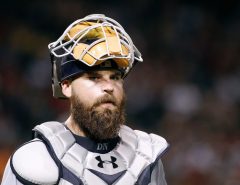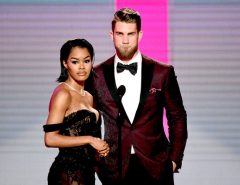On a night where Max Scherzer went 6 1/3 innings, struck out 10 batters and allowed only three hits, the Nationals still lost to the Mets 2-0 as two of those three hits allowed were home runs. It’s the continuation of a disturbing trend for the ace, who has now allowed 13 home runs through the first month and a half of the 2016 season after allowing 27 on the whole of 2015. What gives?
First the good news. Scherzer has been striking out batters at his usual astounding clip of 32%. His walk rate has jumped up a little from last year to sit at 7.6% but that’s nearly identical to his career rate. His velocity hasn’t dropped a bit, and in fact is a little higher than a couple of season ago. He’s not allowing harder hit balls this year, as his hard hit rate also falls in line with his career norms. He’s always been a fly ball pitcher and he has a fly ball rate of just under 50% on the season, as he has had for his whole career.
Some have attributed Scherzer’s struggles with the long ball to fastball command. Most of his home runs have come on his fastball and nearly half of his home runs have come on pitches right over the heart of the plate. It’s a common sense narrative except that fastballs down the middle are an effective pitch for Scherzer. In 2015, according to Brooks Baseball, batters swung and missed on 23% of fastballs Scherzer threw right down the middle. That’s a higher swing and miss rate than either corners of the strike zone. In 2016, batters are struggling to square up fastballs down the middle even more, now whiffing 28% of the time against those pitches, the second highest whiff rate of any section of the strike zone according to Brooks.
Fastballs down the middle aren’t inherently bad for Schezer, but there is no denying he has seen a lot of fly balls turned into home runs as evidenced by his terrifying 21% HR/FB rate. HR/FB is calculated as the total number of home runs allowed over the total number of fly balls allowed. HR/FB tells a more in depth story than HR/9, another popular stat, although Scherzer’s HR/9 of just over 2.0 is also terrifying in its own right. HR/FB is a rate stat and shows how effective or ineffective a pitcher has been on his fly balls allowed. Considering that Scherzer’s HR/FB rate last year was only 10.5% and his career high was 12.6% coming into this season, it goes without saying that Scherzer has seen more fly balls clearing the fences his year than ever before.
The thing with HR/FB rate is that pitchers have a very difficult time controlling the rate of fly balls that turn into home runs. Pitchers have control over the rate of fly balls allowed, to some extent, but how those fly balls turn into home runs is largely out of their control and pitchers tend to cluster around the league average of 11%. Don’t believe me? Let’s do a little case study with the pitchers who had the highest HR/FB rates last season.
The “leader” on the year for this stat was James Shields who allowed 17.6% of his fly balls to turn into home runs while pitching in the generally pitcher friendly Petco Park in San Diego. Pretty damning stuff huh? Well, in 2014 that rate was only 9.7% and so far in 2016 Shields has a 13.3% HR/FB rate. Moving down the list, Shields’ former teammate Ian Kennedy checks in at second place with a rate of 17.2%. In 2014, he allowed only 7.8% of his fly balls to turn into dingers and so far in 2016 he’s allowing only 10.6%. Brett Anderson was third on the list last season, but he has been injured so much in every other season it’s hard to do a fair comparison. Next up is Rubby de la Rosa, at 16.8% in 2015. In 2014, he was at 11.5% and in 2016 he’s at 13.5%. Following closely behind was CC Sabathia at 16.6%. That represented an improvement over 2014 when he allowed a rate of 23.3%, but so far in 2016 he’s allowing only a 3.4% HR/FB rate. Let’s round the list out with ace Felix Hernandez, who put up a 15.3% HR/FB rate in 2015. That was coming off of a 10.1% rate in 2014 and he’s since allowed an 11.9% rate so far in 2016. In short, for four of those six pitchers, 2015 represented a major step back in home runs allowed from 2014. Five of those six league leaders in HR/FB in 2015 have seen noticeable improvement in 2016. HR/FB rate is just not a “sticky” stat.
Scherzer certainly can improve in some areas. While his walk rate isn’t bad, he has seen an uptick so far this season over last season and it would be nice to see him reclaim some of the gains he made last year. Scherzer himself has said that he has noticed a few small mechanical tweaks that he wants to make. And while the dingers Scherzer has been allowing have certainly not been enjoyable to watch, it’s hard to imagine them continuing at the current pace. Of the 13 home runs allowed so far this year, five have been classified by ESPN Home Run Tracker as “just enough,” or balls that only barely cleared the fence. Had a stiff breeze kicked up at the right time, those five balls may not have cleared the fence at all and could have fallen harmlessly into a defender’s glove instead. That lends credence to the math that suggests that Scherzer’s rate of home runs allowed has to regress closer to the norm. Of course, the home runs he has already given up will linger in the back of everyone’s minds until Scherzer strings together a couple of homerless starts, and the Nationals would love for that happen as soon as possible.
Tags: Max Scherzer




Did you see this article by Mike Petriello on MLB last year, on the same topic but with a somewhat different conclusion? http://m.mlb.com/news/article/135127920/max-scherzer-racking-up-strikeouts-fly-balls/
He’s looking at 2015 numbers, so it’s going to differ, but I thought the bubble graph was interesting. Max shows up as very much an outlier, for (according to Petriello) inducing weaker contact than most on fly balls, for some unexplained reason.